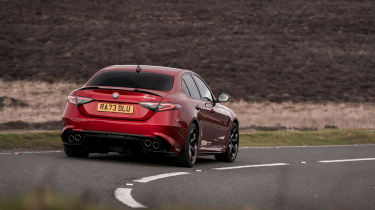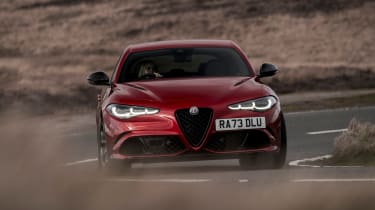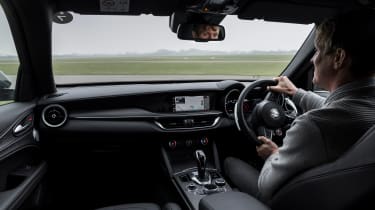Alfa Romeo Giulia Quadrifoglio – ride and handling
Powerful turbocharged rear-wheel drive cars rarely feel as approachable and exploitable as the Giulia Quadrifoglio
Before you even start the Giulia Quadrifoglio you get the feeling that the team behind this car really cares about driving. You sit low, with your entire body hugged by the optional carbonfibre-backed Sparco seats. The generous range of adjustment on the steering column means you can pull the steering wheel into the exact position you want, too.
The starter button is positioned on the steering wheel while two long aluminium paddles, that follow the curve of the rim, are mounted on the column. Both feel very Ferrari-esque. But that’s no surprise, because Alfa poached engineers from Ferrari to help develop the Giulia.
> The best saloons on the market in 2024
Another aspect of the Alfa that feels oh-so Ferrari is the steering. Just metres down a road you become aware that the Giulia has a very fast steering rack, more than a little reminiscent of that found in the Ferrari 458 and 488. But the Quadrifoglio isn’t a rabid, spiky animal. The delivery from its 2.9-litre V6 is progressive and linear.
There’s a suppleness to the chassis which feels odd for a car with such a sporting bent. The ride is rounded and plush, unlike the firm ride some of the Alfa’s rivals exhibit. It’s only as you begin to really push the Giulia that the softer chassis feels slightly lacking in body control, and a touch too much roll is apparent. The stiffer anti-roll bar in the updated 2024 and altered damper software helps in this regard.
The Giulia's DNA drive settings allow you to stiffen up the dampers as well as sharpening the throttle, adding weight to the steering and making the exhaust a bit louder. There are four DNA driving modes selected by a small rotary knob on the transmission tunnel. Advanced Efficiency (A) is the most fuel efficient and allows one bank of the V6’s cylinders to shut down.
More reviews
In-depth reviews
Long term tests
Reviews
Next up is Natural (N), but Dynamic (D) and Race (R) are where it gets interesting as the throttle, exhaust, gearshift, suspension and steering all ramp up the involvement. The exhaust sounds bassier too, and you get either a satisfying crack or a slightly mediocre burp at every upshift.
Dynamic firms up the dampers, but the car still feels compliant. Should you wish to have the noise, steering and throttle of Dynamic with the softest suspension, a button in the middle of the DNA dial allows you to relax the dampers.
Race mode is firmer still, but just as in Dynamic you can back the dampers off to a softer setting; not fully soft, but the same setting as the default in Dynamic. No matter which mode you’re in though, the suspension never feels unbearably stiff. Only the very bumpiest of roads makes Race feel less than ideal, but the slightly tighter body control is still preferred by some of the evo team. Others prefer the more compliant modes, as it never really feels wayward or unrestrained. Either way, there’s a setting to suit everyone.
Race mode also disables the ESP and traction control – it’s the only way to deactivate the safety systems. Away from open B-roads and in town the pre-2024 Giulia revealed some slight quirks. It shakes and rocks at idle and the diff is reluctant to lock up; the inside rear wheel often spins as you leave junctions. The carbon ceramic brakes are very hard to modulate at low speeds, and you find yourself fighting the car as it wants to creep forward until you add more and more pressure to the middle pedal to stop it.
These low speed peculiarities are easy to overlook, though, because the Alfa is such an accomplished car when driven enthusiastically. On track the Giulia’s soft compliant suspension is still more than capable, although it is at its best in Race mode. The engine and drivetrain work together to allow a fantastic degree of adjustability, and you can control and balance the car from apex to exit.
Up until 2024, the Quadrifoglio didn’t always want to play the hooligan like its rivals. Provoked into a slide, the electronic diff could contradict your actions and push you straight. After one or two corners of tomfoolery the diff could call time, flashing a ‘Service ATV System’ message on the dash. It would then fail to lock up, acting instead like an open differential. Giving some time to allow the diff to cool, it would be possible to continue. The mechanical locking diff in post-2024 cars has solved this problem.




